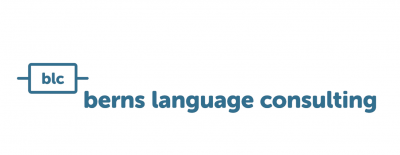Machine translation
Your translation volumes and cost increase constantly?
Worry no more! In the age of AI, you can reduce your translation cost immediately. How? With trained machine translation (MT), which speaks your company’s language!
We help you select and train the best MT engine for your company and use case. And at the same time, we help you keep your valuable language data safe and secure.

Machine translation conquers the world.
Machine translation conquers the world.
Thanks to rapid progress in the field of artificial intelligence, we no longer wonder if machine translation makes sense. Instead, many new questions arise in companies:
- Do we have enough data for engine training?
- For which use cases and workflows can we efficiently apply MT?
- How can we offer MT to all employees?
- How do we track and optimize MT quality?
- Which post-editing rules should our translators apply?
The growing diversity of systems also presents customers with the difficult choice of the right MT system.
Machine translation usually remains a black box for customers. This makes objective, system-independent, and competent support all the more important. Our computational linguists help you select, onboard, and operate the right MT system for your company, use cases, and processes.
With our MT expertise, you master your translation stream.
How can ever-growing language volumes be translated? With machine translation!
Of course, machine translation requires well-maintained data for efficient use: We help you analyze existing data and optimize it for your MT training. In addition, we help to analyze machine translation scenarios in your company. And of course, we support you with MT training, testing, and optimizing.

What is machine translation?
Simply explained, machine translation is fully automated translation without human interaction in the translation process. For large volumes of source texts, MT generates translations for the desired target language in real-time. A while ago, three main MT methods were applied, rule-based, statistical, and neural machine translation. Today, all really interesting MT systems are based on so-called neural methods. Therefore they are called NMT systems which stands for Neural Machine Translation.
Neural machine translation
Neural machine translation (NMT) is the newest machine translation technique. NMT is based on the analysis of large bilingual texts. In order to do so, NMT uses word embeddings: The machine learns abstract representations of words from the context in which words appear in a sentence. The processing of word embeddings in neural networks allows the NMT to produce sentences that sound a lot more human than previous methods did. Training a good NMT engine ideally requires customer-specific training data. Many system suppliers offer pre-trained base engines that are then specialized with customer data.
This is how we help you to apply machine translation efficiently.
1. MT Scoping
Essential: expectation management! Ideally, the requirements of process managers and important stakeholders are considered from the start. Have lots of conversations with project managers, IT experts, translators, and main user groups. If everyone is aware of machine translation use cases and resources, you can take specific steps to select MT systems. We at blc support our customers in the scoping process: We conduct stakeholder interviews and provide consulting for all areas of machine translation before, while, and after system integration.
2. MT Pre-Processing
After scoping, it is vital to test the suitability of available resources for machine translation training. After extracting relevant data from various file formats, the data needs to be cleaned. In addition to the linguistic and formal correctness of bilingual translation units, we at blc also check terminology resources. If necessary, we will use term extraction to include more resources. For data-sensitive use cases, we apply anonymization procedures. After ensuring the quality of the data, we aggregate domain-specific content and prepare it for MT training. We pay particular attention to the creation of representative test sets. These test sets are then applied to evaluate the quality of the trained engines.
3. MT Training
Using customer data, we train your MT engines in selected MT systems. MT system offerings differ in terms of available language directions, training resources, configuration options, and pre-trained base engines, which are then specialized with customer data. Note that training can take from less than one up to several days, depending on data volume. With these newly trained MT engines, we then translate our previously created test sets. These translations are the base of the following MT evaluation.
4. MT Evaluation
The evaluation of MT quality is one of the most important steps, in an MT selection process but also to assess the quality of your productive MT engines. Automatic evaluation compares machine-generated translation with the human translation of the same set of sentences. This results in a score that expresses the similarity between machine and human translation. The best-known score, which is mostly used at the moment is BLEU (Bilingual Evaluation Understudy).
BLEU and comparable metrics are not able to assess the accuracy of a machine translation in detail. Therefore, human evaluation is still the most precise measure of assessing the MT. Human evaluation can be either holistic, analytical, or both. Holistic evaluation measures the readability and accuracy of machine translation using scales. It provides a fast, qualified mean value across all sentences in a test set. Analytical evaluation provides more detailed information. Based on a defined error metric, the evaluators annotate error types in machine translation. The summary of these results provides valuable information for optimizing MT engines.
Another important factor in MT evaluation is the analysis of post-editing effort. As part of the MT evaluation, the so-called edit distance provides information about how much effort was needed by a post-editor to finalize each machine-translated sentence. The smaller the edit distance for a sentence, the fewer changes had to be made, and the better the MT output. Together with automatic and human evaluation, the edit distance provides a comprehensive picture of the quality and suitability of MT engines at a given time.
5. MT System Selection
You may be wondering how to choose the right MT system provider. The results of the MT evaluation serve as the basis for selecting an MT system provider that is most suitable for you. On the other hand, requirements and financial framework also play an important role in the decision process. In this phase, an objective comparison and presentation of the most important system features and evaluation results is vital. The cost/benefit ratio in a sound business case as well as interviews with MT system providers and reference customers complete the picture. Once all professional and technical questions have been answered, you can select your MT system based on solid information.
6. MT Integration & Post-Editing
After you have decided on a system, the implementation of your MT use cases must be tackled. The central aim here is to integrate machine translation into your company’s existing system landscape: translation and content management systems are connected to the MT system, MT self-service portals are set up for company-wide MT use, and workflows are configured for a smooth post-editing process. To ensure that the MT system remains up-to-date, we support you with MT evaluation and re-training processes. Here the automatic quality estimation of MT plays an important role: Customer-specific estimation models are trained based on neural methods, resulting in a quality risk estimation score. This score helps post-editors, to keep the effort of fine-tuning the MT to a minimum.
We help you to build up your MT process, and we are also happy to provide support in your productive MT process, should you need it.
Use case “Machine translation in the pharmaceutical industry”
Challenge: A large pharmaceutical company wanted to know whether the use of machine translation could be worthwhile in the company. They also wanted to know how to approach machine translation.
Solution: We reviewed user scenarios, interviewed stakeholders, analyzed data and created a business case. On the basis of this data, we have started a project to introduce machine translation. The project provides a resource in the productive translation process as well as in the form of a ‘self-service portal’ for the employees. The project is very successful.
Use case “Machine translation in development”
Challenge: As part of a strategic project for a major german automotive manufacturer, we examined the prerequisites that must be met in order for machine translation to be effectively integrated into an existing documentation process.
Solution: As part of the project, berns language consulting has created a functional pilot and examined the following aspects:
- Integration of existing terminology
- Pre-processing of texts and treatment for the most precise results possible
- Integration of the engine into the existing translation workflow
- Ensuring data security, anonymization scenarios
We are your faithful companion at every step on your machine translation journey.
MT strategy & user scenarios
- Define MT strategy and user scenarios
- Determine and prioritize MT requirements
- Analyze and clean up data for MT training
MT system evaluation
- Extract text and terminology for MT training
- Train MT engines of various system providers for comparison
- Evaluate results and select the best MT system
- Integrate automatic MT quality measurement methods
MT optimization
- Optimize MT engines via re-training, data enrichment
- Integrate MT systems into system landscape
- Share knowledge, train teams, create post-editing guidelines
How can machine translation help my company?
Machine translation helps your company manage translation more efficiently. How? By adding an MT component to your existing pre-translation process with translation memories. This means that translations are available a lot faster. Another time-saving factor with MT: With the right training resources, the MT delivers domain-specific translations that take your terminology into account and make a time-consuming terminology post-processing step superfluous.
By integrating machine translation into central translation portals, content, and product management systems, all employees as well as b2b and b2c communications will benefit from real-time translation into all corporate languages.

Do you think your company could use more efficient translation management? Let us help to speed up your translation processes with machine translation. We are also happy to consult you on professional translation software. Get in touch, we are more than happy to help!


